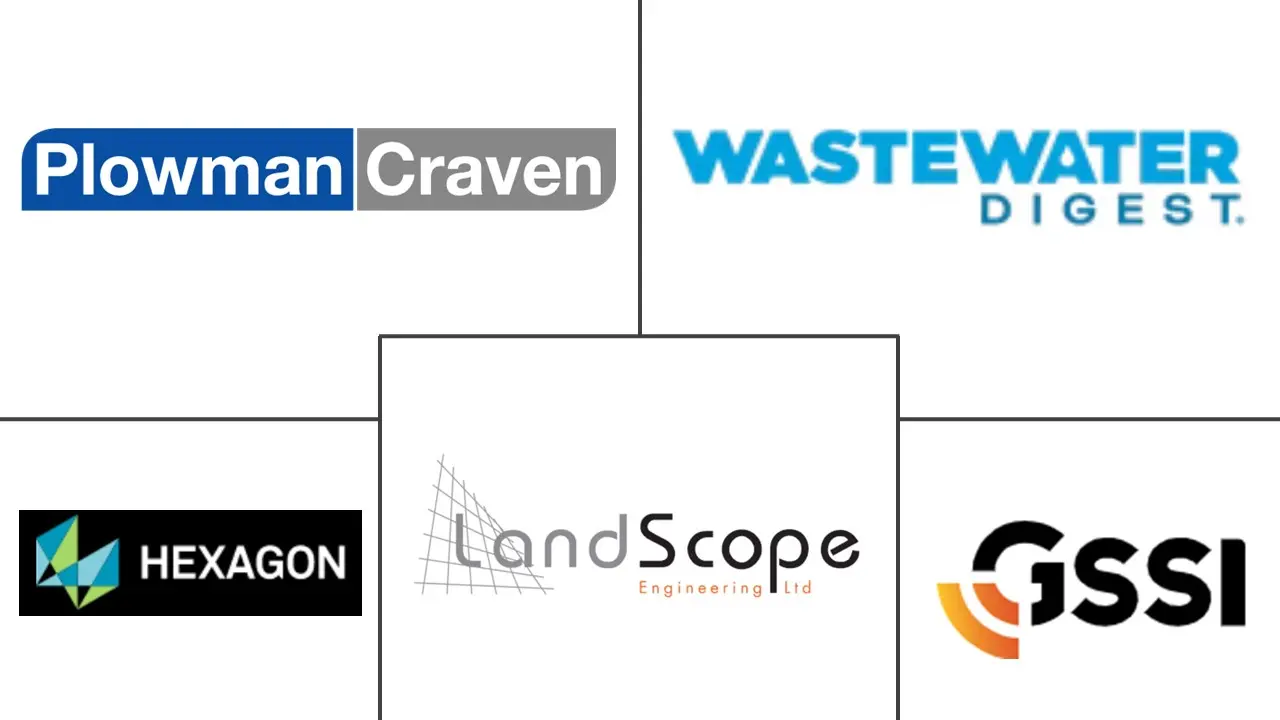Underground Utility Mapping Market Size and Share
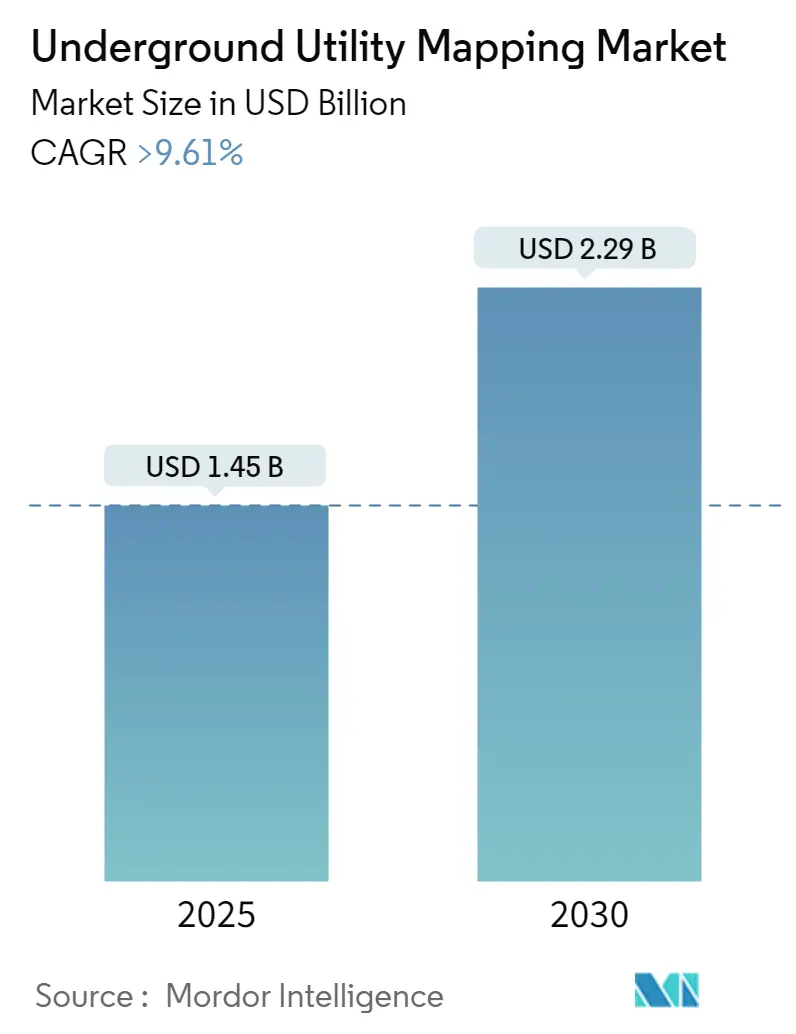
Underground Utility Mapping Market Analysis by Mordor Intelligence
The Underground Utility Mapping Market size is estimated at USD 1.45 billion in 2025, and is expected to reach USD 2.29 billion by 2030, at a CAGR of greater than 9.61% during the forecast period (2025-2030).
Two primary factors are propelling the underground utility mapping market: heightened economic activities, especially in developing nations, and increasing government initiatives aimed at maintaining these underground utilities.
- In recent years, the subsurface utility engineering (SUE) industry has been at the forefront, crafting innovative solutions to the challenges of mapping underground utility infrastructures. By melding geophysical technologies, such as electromagnetic locators and ground-penetrating radars, with non-technical methods like historical records, the industry is able to amass a comprehensive dataset of subsurface infrastructures.
- Moreover, the World Economic Forum anticipates that global investments in urban grey infrastructure will skyrocket to USD 10,548 billion by 2030. Such monumental urban development investments herald a significant growth opportunity for the underground utility mapping market.
- As urbanization accelerates, the global trend of smart cities is gaining traction. The United Nations projects that by 2050, urban populations will swell by 404 million in India, 292 million in China, and 212 million in Nigeria.
- Meanwhile, Latin America, an emerging continent, is experiencing the swiftest urbanization. With numerous global smart city projects in motion, international investments are pouring in. The Organization for Economic Cooperation and Development (OECD) estimates that from 2010 to 2030, global investments in smart city initiatives will near USD 1.8 trillion, encompassing all metropolitan infrastructure projects. This surge in smart city developments is set to amplify demand in the underground utility mapping market.
- Infrastructure planning, often sidelined in urban development, is vital for the seamless operation of complex facilities. A pivotal tool in this endeavor is 3D utility mapping, which provides a three-dimensional perspective of an area and its utilities. This method captures subsurface data, encompassing water, sewer, and gas lines, alongside structural maps and electrical wiring. Armed with a detailed 3D utility map and a Conceptual Site Model (CSM), planners can swiftly pinpoint challenges and devise effective solutions.
- By merging emerging technologies with utility maps, the underground utility mapping market is undergoing a transformation. These advancements bolster the accuracy, efficiency, and safety of exploration activities. Consequently, exploration teams can adeptly navigate challenges tied to underground infrastructure, streamline their routes, and mitigate risks, driving the market's growth and fostering innovation.
- While Ground Penetrating Radar (GPR) excels at pinpointing the horizontal locations of targets, various factors can sway the speed and precision of depth measurements. Soil type and moisture content are pivotal. For instance, radar signals slow down in challenging soils like sand and clay. Moisture-rich materials further influence signal speed. Thus, while pinpointing the exact speed of GPR signals across different materials poses challenges, estimates generally hover around 90% accuracy.
Global Underground Utility Mapping Market Trends and Insights
Ground Penetrating Radar is Expected to be the Largest Component Type Solution
- Ground-penetrating radar (GPR) stands out as the premier choice for utility mapping, emitting directional electromagnetic waves in the MHz and GHz range. By analyzing the return of these signals, GPR accurately pinpoints the location of underground utility infrastructure.
- GPR technology is notably adept at identifying both metallic and nonmetallic utilities. Utility surveyors favor GPR for its swift data acquisition, cost-effectiveness, and high-resolution imagery in utility mapping surveys.
- Beyond utility mapping, GPR serves as a non-destructive tool for evaluating concrete structures, revealing insights on rebar placements, slab thickness, and the presence of voids or conduits. This non-invasive approach not only ensures precise results but also minimizes disruptions to ongoing construction projects.
- In a forward-looking move, drone manufacturers are crafting GPR-enabled drones, hinting at a burgeoning market opportunity as they become poised to detect underground utilities.
- With the expansion of natural gas pipelines, the demand for precise mapping and monitoring intensifies. Ground penetration techniques play a pivotal role in locating, identifying, and evaluating pipeline conditions, all while safeguarding the surrounding environment. As of February 2024, data from GGON highlights China's dominance in the global gas pipeline landscape. Boasting 442 operational pipelines and an additional 302 either proposed or under construction, China's network is a significant contributor to the global tally of over 1,500 operational gas pipelines.
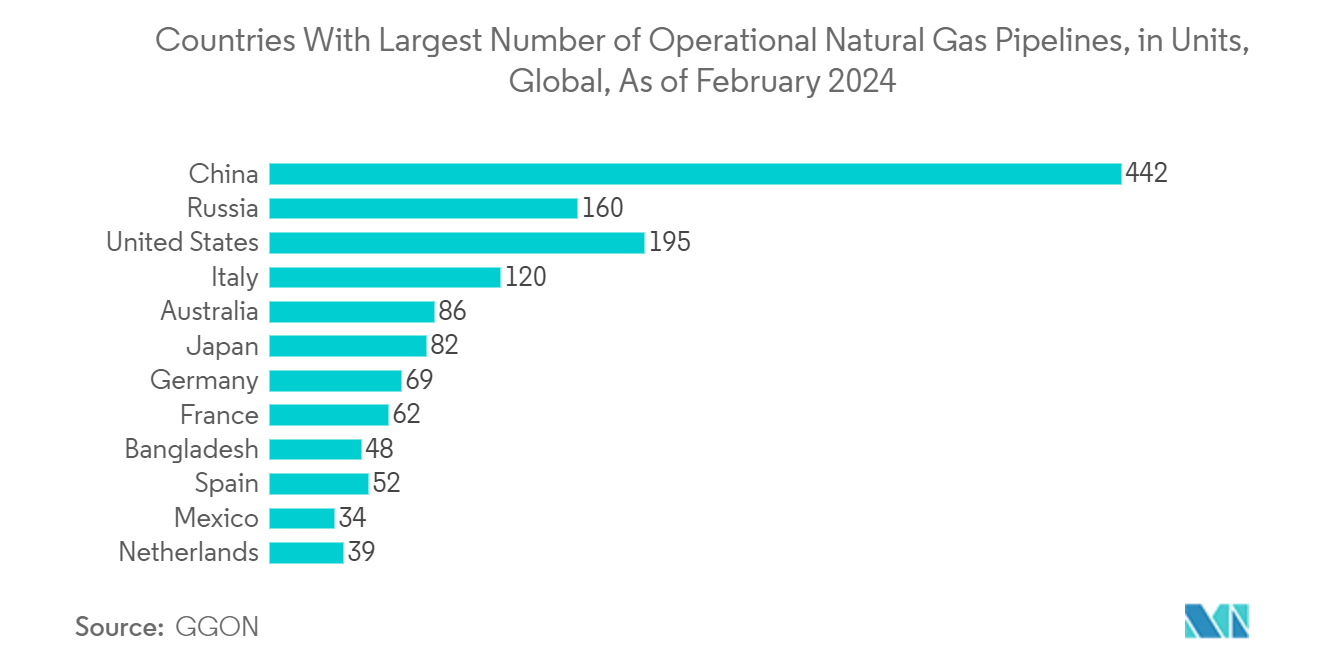
North America Holds Largest Market Share
- In North America, rapid urbanization and population growth are straining existing infrastructure systems, leading to a heightened demand for underground utility mapping services. The complexity and density of urban areas necessitate precise mapping to prevent damage to underground utilities during construction.
- The National Underground Asset Registry Advisory Group reports that the challenge of locating underground utilities costs the U.S. economy approximately USD 50 billion annually. This issue has also led to over 1,500 injuries and nearly 400 fatalities in the past two decades. Furthermore, inaccuracies in underground utility mapping contribute significantly to delays in highway construction. Such uncertainties are driving the adoption of advanced technology-based solutions in the region.
- Numerous cities and municipalities across North America are channeling investments into smart city initiatives. These efforts aim to harness technology for better infrastructure management, enhanced public services, and optimized resource allocation. Within this context, underground utility mapping plays a pivotal role, offering vital data for infrastructural asset management and planning.
- Efforts are underway in the region to develop methods for sharing data on underground utilities, especially those captured during construction. A notable example is the City of Chicago's pilot program, which aims to deploy a platform for data collection and sharing a 3D map of the subway.
- Regional players are increasingly adopting inorganic growth strategies to capture larger market shares, further propelling the segment's growth. Additionally, many public works departments in the region are utilizing GIS technology to pinpoint the locations of underground utilities.
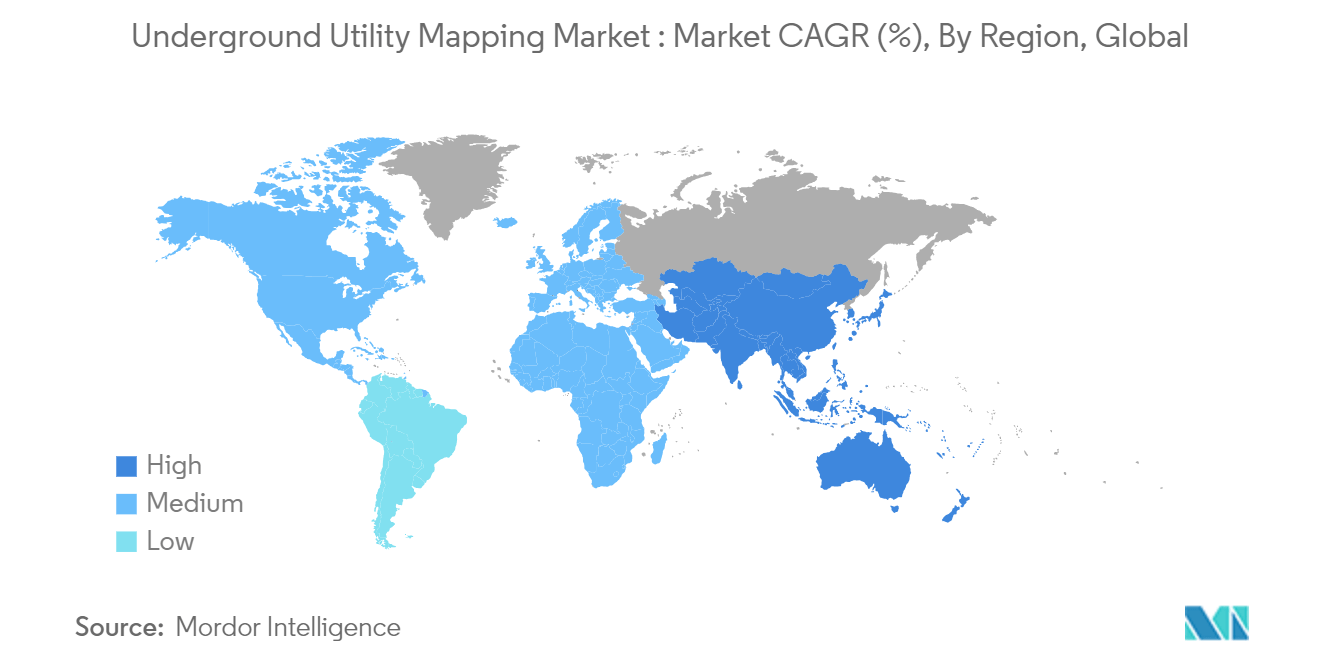
Competitive Landscape
The underground utility mapping market features a semi-consolidated landscape, characterized by the coexistence of global giants and a multitude of small to medium-sized enterprises. Key players shaping the market include Hexagon AB, GSSI Geophysical Survey Systems Inc., LandScope Engineering Ltd, Plowman Craven Limited, and Geospatial Corporation. These players are strategically leveraging partnerships and acquisitions to bolster their product offerings and secure a competitive edge.
For example, in April 2024, USIC, LLC ("USIC"), a prominent player in underground utility damage prevention, forged an official partnership with the U.S. Army's Partnership for Your Success (PaYS) Program. This initiative provides American soldiers with opportunities to serve their country while simultaneously preparing for their post-service careers. The partnership was ceremoniously signed at USIC's corporate headquarters, with the event being hosted by the Indiana Army National Guard Recruiting and Retention Battalion. As a recognized PaYS Partner, USIC pledges to offer soldiers an interview and a shot at employment once they conclude their Army tenure. This strategic alliance not only facilitates a smoother transition for soldiers into civilian life but also underscores the US Army's dedication to nurturing strong relationships with the corporate sector.
Underground Utility Mapping Industry Leaders
-
Hexagon AB
-
GSSI Geophysical Survey Systems, Inc.
-
Landscope Engineering Ltd
-
Plowman Craven Limited
-
Geospatial Corporation
- *Disclaimer: Major Players sorted in no particular order
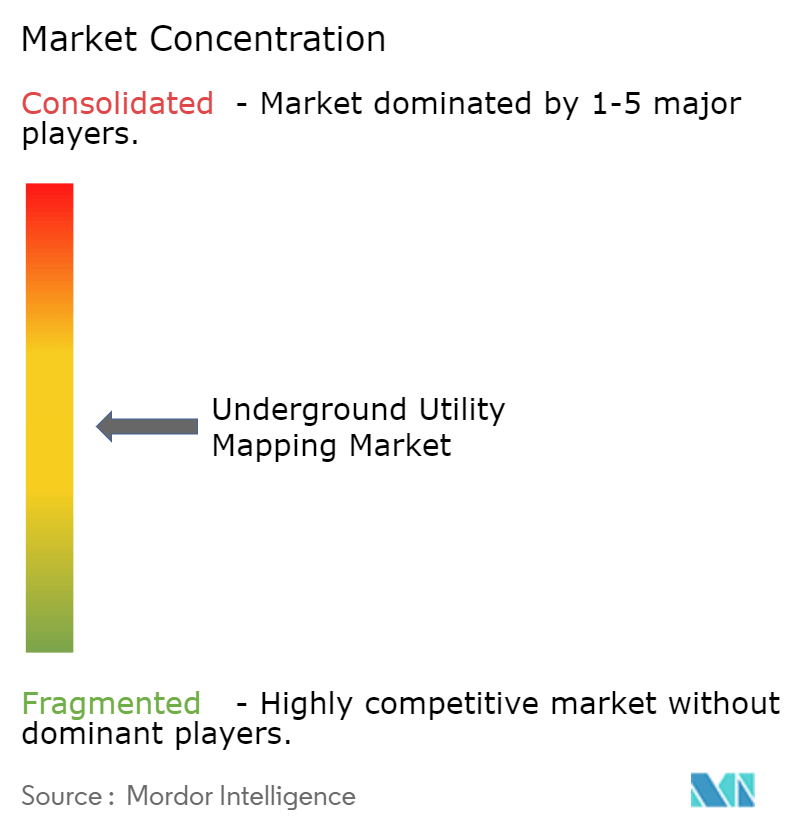
Recent Industry Developments
- March 2024: WSB LLC, a rapidly expanding infrastructure engineering and consulting firm in the US, has partnered with 4M Analytics, a leading provider of AI Mapping and Analytics Solutions for subsurface utilities. This collaboration aims to bolster infrastructure projects nationwide, emphasizing data integrity and real-time digital solutions. Utilizing its Digital Construction Management (DCM) service, WSB enhances civil construction projects through model-based digital delivery. Their comprehensive offerings include construction modeling, 4D scheduling, and automated machine control. Recognizing the complexities of modern infrastructure projects, WSB is committed to advancing the industry by improving efficiencies, streamlining processes, and mitigating risks.
- February 2024: Under the GOPHURRS program, spearheaded by the US Department of Energy’s ARPA-E, Exodigo has pledged to deliver accurate and detailed subsurface maps. These maps are designed to optimize the undergrounding of power lines, bolstering their reliability, resilience, and security.
Global Underground Utility Mapping Market Report Scope
Accurate information on existing underground utilities is required to plan and install new utilities and excavate existing utilities. The subsurface utility mapping market scope tracks the adoption of various solutions and services used by multiple end-use industries such as electricity, public safety, building and construction, oil and gas, telecommunication, etc. The report also focuses on the effects of the pandemic on the ecology of the utility mapping market. The scope includes the existing vendor landscape for significant market players.
The underground utility mapping market is segmented by component type (solutions and services), by end-user industry (public safety, oil and gas, building and construction, telecommunication, electricity, and other end-user industries), and by geography (North America, Europe, Asia Pacific, Latin America, and Middle East and Africa). The market sizes and forecasts are provided in terms of value (USD) for all the above segments.
| Solutions | Ground Penetrating Radar |
| Electromagnetic Locators | |
| Other Solutions | |
| Services |
| Public Safety |
| Oil and Gas |
| Building and Construction |
| Telecommunication |
| Electricity |
| Other End-user Industries |
| North America |
| Europe |
| Asia |
| Australia and New Zealand |
| Latin America |
| Middle East and Africa |
| By Component Type | Solutions | Ground Penetrating Radar |
| Electromagnetic Locators | ||
| Other Solutions | ||
| Services | ||
| By End-user Industry | Public Safety | |
| Oil and Gas | ||
| Building and Construction | ||
| Telecommunication | ||
| Electricity | ||
| Other End-user Industries | ||
| By Geography*** | North America | |
| Europe | ||
| Asia | ||
| Australia and New Zealand | ||
| Latin America | ||
| Middle East and Africa |
Key Questions Answered in the Report
How big is the Underground Utility Mapping Market?
The Underground Utility Mapping Market size is expected to reach USD 1.45 billion in 2025 and grow at a CAGR of greater than 9.61% to reach USD 2.29 billion by 2030.
What is the current Underground Utility Mapping Market size?
In 2025, the Underground Utility Mapping Market size is expected to reach USD 1.45 billion.
Who are the key players in Underground Utility Mapping Market?
Hexagon AB, GSSI Geophysical Survey Systems, Inc., Landscope Engineering Ltd, Plowman Craven Limited and Geospatial Corporation are the major companies operating in the Underground Utility Mapping Market.
Which is the fastest growing region in Underground Utility Mapping Market?
Asia Pacific is estimated to grow at the highest CAGR over the forecast period (2025-2030).
Which region has the biggest share in Underground Utility Mapping Market?
In 2025, the North America accounts for the largest market share in Underground Utility Mapping Market.
What years does this Underground Utility Mapping Market cover, and what was the market size in 2024?
In 2024, the Underground Utility Mapping Market size was estimated at USD 1.31 billion. The report covers the Underground Utility Mapping Market historical market size for years: 2019, 2020, 2021, 2022, 2023 and 2024. The report also forecasts the Underground Utility Mapping Market size for years: 2025, 2026, 2027, 2028, 2029 and 2030.
Page last updated on:
Underground Utility Mapping Market Report
Statistics for the 2025 Underground Utility Mapping market share, size and revenue growth rate, created by Mordor Intelligence™ Industry Reports. Underground Utility Mapping analysis includes a market forecast outlook for 2025 to 2030 and historical overview. Get a sample of this industry analysis as a free report PDF download.
